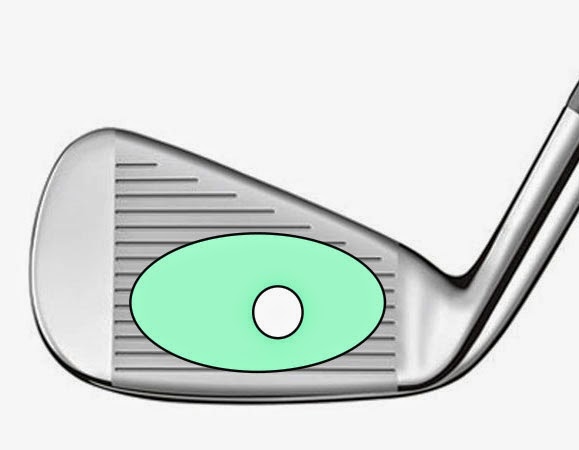Webster holds one definition for FORGIVING as "allowing room for error or weakness". I think that's dead on the money of what club manufacturers are going for. I don't think that's what they got. I think what they came up with were more compensatory irons than forgiving ones. We all want to hit the ball as far as we possibly can and as often as we can. Of course, to do that we need to hit the ball in the center of the club. It's as simple as that.
 |
| THE sweet spot is the point of contact where the mass of the club is the most resistant to twisting thereby transferring the most energy to the ball (WHeWW!) |
 |
| The FORGIVING sweet spot |
Still....The issue that I believe and have personally noticed is that this forgiving nature is a burden to true shot making. During the course of my testing between the Maltby irons and my AP2's, I noticed that when I tried to work the ball left or right with the AP2 irons I was able to do so with nearly perfect control only on a dead center impact. If I hit it on the toe or heel I would actually get an over correction leading to some funky directional issues and bad thoughts about what I had just hit. I repeated this test with my Cobra Carbon CB irons, which had less forgiveness technology than the AP2 but still were not a blade. I noticed the same issue, but not as pronounced. I felt much better about those irons and I was able to have more control over the very minute movements of the ball but there was still some minor over correction when I hit off-center. Now, I'm no Iron Byron machine, but after a couple of buckets and a roll of impact tape, I found that even the dead center impact shots from both irons were dispersing from where I was hitting them by a few yards. I found with the blades, there was no such correction. When it went straight it was like it was on a rope and even swings that were less than accurate were within tolerances. The distance off those blade miscues died an awful death, but they stayed online. You could put a small blanket over the shots where they landed whereas with the correction irons, it was more like a king size bed sheet. This got me thinking about what I really, REALLY want in a club - irons particularly - and how much of the hype I should be listening to.
As a solid 3.5 index, my irons are my game. I NEED accurate shots into pins. I NEED control of my shots and to know that when I hit the ball in that direction, it's going to go that way 100% of the time when I hit it well. I want to knock down pins and scare the hole from just about anywhere. I'm also not bad at ball-striking so I opted for the blades in my high lofted irons. This test has me seriously considering my 5 through 7 irons as well whereas I was looking at replacing them with cavity-back irons before.
After all this, I've come to the opinion that if a player plays to a 6 handicap or below, they should probably be playing blades. They will make you better faster than any other "forgiving club", and the good news is that every manufacturer has a version so your brand loyalty is intact. So I pose this to my bored readers test out a set against your own sometime and see what shakes loose. Are you playing the irons you WANT or the irons you NEED?
No comments:
Post a Comment